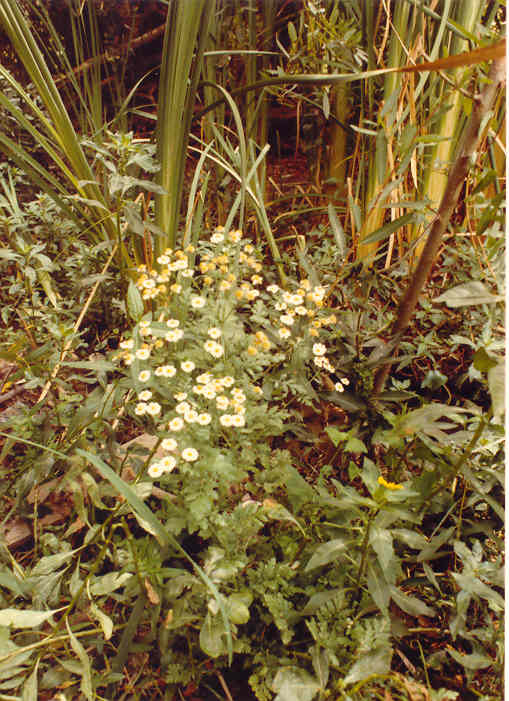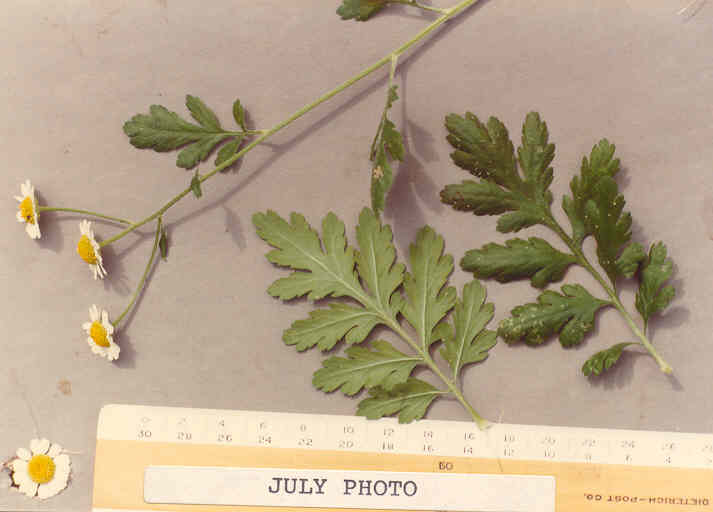
Tanacetum parthenium (L.)
Schultz-Bip.
=Chrysanthemum parthenium
Asteraceae
(Sunflower Family)
Europe
Fever-Few
 |
Tanacetum parthenium (L.)
Schultz-Bip.
=Chrysanthemum parthenium
Asteraceae
|
July Photo
Plant Characteristics:
Aromatic perennial with a woody caudex;
stems leafy, subglabrous, 3-8 dm. high; lvs. pinnatifid with rounded to
pinnate segms., blade to 7 cm. long; heads 10-30, corymbose in dense flat topped
clusters; disk 5-9 mm. wide; rays white, ca. 10-20, 4-8 mm. long; phyllaries in
2-3 series, leathery, sparingly hairy, margins transparent; aks. 8-10 nerved.
Habitat:
Common in disturbed urban areas, roadsides, fields, generally below 250
m. Sierra Nevada Foothills, Central Valley, San Francisco Bay area, outer south
Coastal Ranges, south coast. June-Sept.
Name:
Greek, chrusos, gold, and anthemon,
flower. (Munz, Flora So. Calif. 140).
Greek, parthenios, maidenly,
pure. (Jaeger 183).
"Feverfew" is a corruption of "febrifuge" from its
fever-lessening properties. (Hatfield
82).
General:
Rare in the study area having been found in only twice, first in the 23rd
St. area
and several
years later under the
willows at North Star Beach. (my
comment).
"Several years ago I lived in a house plagued by mosquitoes.
When I told my neighbor about the problem, she suggested that I get a
mosquito coil, a spiral shaped device that is burned.
Smoke from the mosquito coil kills mosquitoes. I tried one and it worked like a charm. Later I learned that mosquito coils contain the natural
insecticide pyrethrin, which comes from the flowers of several different species
of Chrysanthemum.
For many years pyrethrins were widely used in insect sprays, but during
the 1950's and 1960's pyrethrin sprays were gradually replaced by synthetic
insecticides such as DDT, malathion, and chlordane.
Pyrethrins are safer because they decompose rapidly when they fall to the
ground, quickly losing their poisonous properties." (Eshelman 172). Feverfew is an old remedy used
to relieve migraine headaches. (John
Johnson). Chrysanthemum
species have been known to cause hay fever and asthma.
(Fuller 379). It was once a plant of consequence
which was set around dwellings in the belief that it purified the air and kept
disease at bay. It also served as a
medicine to cool feverishness, to quiet palpitations and to calm nervousness and
lift up low spirits. Culpepper
recommended feverfew for women who had just given birth, "to remedy such
infirmities as a careless midwife has caused".
A decoction of the weed's flowers in wine, made more palatable by a dash
of nutmeg, was a Tudor remedy for many other of women's ailments. A very ancient
belief, which retains much truth, is that the infusion of feverfew's flowers had
an aspirin-like sedative effect that would reduce any distressing sensitiveness
to pain. It also relieves
toothache, earache, neuralgia, and some rheumatic pains.
The infusion that tackles all of these is made by pouring 1.25 pints of
boiling water over 1 ounce of the herb, fresh or dried and it is taken
frequently when it is cold, in doses of half a teacupful.
(Hatfield 83-84). T.
vulgare, or tansy, has been said to add
to the medicinal virtues of aromatic bitters the qualities of an irritant
narcotic. While it may be capable
of beneficial use in the hands of a skilled person, it should be greatly
diluted, 1 teaspoonful to a pint of water. (Meyer 126). About 100 species, chiefly of N.
Hemis., and Old World. (Munz, Flora
So. Calif. 140).
Text Ref:
Hickman, Ed. 350; Munz, Flora So. Calif. 140.
Photo Ref:
July 1 84 # 14,15.
Identity: by R. De Ruff, confirmed by F. Roberts.
Computer Ref:
Plant Data 155.
Have plant specimen.
Last edit 10/21/02.
 |
July Photo